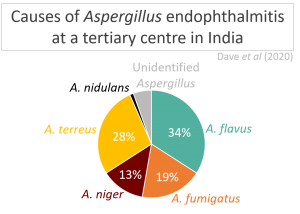Submitted by Aspergillus Administrator on 19 June 2012
A recent research paper described a consignment of 100 000 jewelry boxes made in China, bound for a company in France arriving covered in mould – stained inside and out.
Workers refused to handle the boxes and they were send to a laboratory for testing. Aspergillus oryzae (closely related to A. flavus) was identified which closely resembled a strain commonly used for food production in China and Eastern countries in particular – this is unusual and not a strain commonly found in the environment. It is a strain of Aspergillus that is known to occasionally be a human pathogen.
The researchers could not rule out the possibility of this fungal strain producing ‘unknown mycotoxins‘ though they did fail to detect any of several known toxins that were tested for.
If the moulds had been those commonly found in the environment the consignment could well have been cleared for use after cleaning but as this consignment seemed to be contaminated with very few strains (possibly only one) of a fungus not normally found in the environment potential harm to health was not ruled out and the boxes were destroyed.
The authors point out that this incident may be repeated more often in future as global commerce & manufacturing sourcing increases and that great care needs to be taken to prevent contamination of goods at the factory (not allowing the consumption of food in the same place as manufacturing occurs for example) and the accumulation of damp during what is often a lengthy period of transport.
The paper also points out that there may be some toxins hazardous to health produced by fungi that we don’t currently know about or detect, but then seem to only be worried about fungal strains that are not commonly found in the environment. This is a highly cautious approach which probably reflects the need to prevent all possible theoretical risks for the purpose of advising the industry – in point of fact there are many strains of microorganisms that are abundant in the wild capable of producing toxins, many of which we may not know about.
There is a final comment in the paper regarding the treatment of products with biocide
Current regulations (Registration, Evaluation, Authorization, and Restriction of Chemical substances, REACH) now prohibit the use of dimethyl fumarate (DMFu), and this could result in an increase of mold contamination of imported manufactured products. Research should be started to select alternative biocide to replace DMFu.
Overall we must encourage great awareness of the potential for moulds to contaminate goods both during manufacture and transport & storage. Companies were large scale manufacturing of biodegradable goods takes place need to put safeguards in place and companies receiving goods need to be aware of potential health hazards that their workers may come into contact with when opening consignments.
News archives
-
Title
Date



